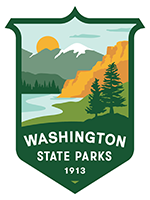The Parks headquarters Information Center is moving from its current location in Tumwater to the Department of Ecology building at 300 Desmond Drive SE in Lacey. Our customer service team is located at the front desk, just inside the main entrance.
Search results
1067 results found
Closure expected to last a full year
Olympia – Kopachuck State Park will close from June 3, 2024 until summer of 2025 for extensive construction and reimagining of the day-use park.
During the construction period, the Washington State Parks and Recreation Commission will build an outdoor amphitheater, a new playground and a large, rentable facility in the upper day-use area. The goal of the project is to provide a park with better infrastructure, all while keeping its neighborhood park feel.
Washington State Parks is currently working on the Classification and Management Planning (CAMP) process for Gingko Petrified Forest State Park. State Parks started the CAMP process in January 2019; however, planning was put on hold in June 2021 when it was determined that additional environmental analysis was necessary. In August 2023, State Parks secured funding to hire PBS Engineering and Environmental to perform an Environmental Impact Statement (EIS) for Recreation Drive Trail, located in the northern portion of the park.
The Washington State Parks and Recreation Commission (Parks) has identified 35 public recreational mooring buoys across western Washington that are at risk of breaking in the future.
Starting this week, Parks will close these buoys, which the agency plans to replace. Even though individual buoys will close, the impacted parks will still have other mooring buoys available for use.
By Holly Sproul (Parks Forms Manager & Web Specialist) & Nephew Evan (Age 9)
For my family, campouts have typically centered around boating and fishing. This summer, my sister and I took my 9-year-old nephew Evan to state parks in different areas of Washington. Here is our just-over-a-week campout experience with Evan’s insight and tips – and some tips from the adults as well.
|
Located on Marrowstone Island, this park is only accessible by beachable watercraft, and the wide pebble beach disappears at high tide; hence, the rack. Part of the Cascadia Marine Trail, Kinney Point State Park Property is a quiet place to spend the night, explore the beach and stretch your legs after a long day of paddling.
Pacific Beach State Park has a long history as a place for travelers to rest as they journey along Washington’s Pacific Ocean coastline.
Indigenous Lands
The park lies within the traditional territories of Coast Salish Indigenous people whose present-day descendants include members of the Quinault Indian Nation and the Confederated Tribes of the Chehalis Reservation.
Ethnographers reported that the mouth of Joe Creek in today’s Pacific Beach State Park served as a “rest stop” for Indigenous people traveling along the coast between trading centers.
Beacon Rock State Park centers on the prominent rock monolith that rises more than 840 feet above the Columbia River, but the park’s landscapes and stories extend well beyond the rock.
Boring Volcanics and Ice Age Floods
Beacon Rock is the core of an extinct volcanic cinder cone that erupted about 57,000 years ago. It is part of a volcanic feature geologists call the Boring Volcanic Field (named for the town of Boring, OR), as is the explosive caldera featured in nearby Battle Ground Lake State Park.
The Washington State Parks and Recreation Commission will hold its regularly scheduled commission meeting virtually on Wednesday, Nov. 15.
Commission meeting items include a camping inventory update from Parks Director Diana Dupuis that covers use and trends at existing camping areas. The Commission will also hear a financial update and discuss its December planning meeting.
Among Lake Sylvia State Park’s peaceful trails and campsites are nearly hidden stories of ventures to wrest timber and hydroelectricity from the landscape.
Indigenous Lands
Lake Sylvia State Park lies within the traditional territories of Coast Salish Indigenous people whose present-day descendants include members of the Confederated Tribes of the Chehalis Reservation.
Westport Golf, Inc. has developed a proposal to construct, operate, and manage a Scottish links-style “artisanal” golf course and a 30- to 40-room inn at Westport Light State Park near Westport. Given the potential impacts of the proposed project, an extensive environmental review process is needed before the Washington State Parks and Recreation Commission will formally consider the proposal.
OLYMPIA – May 1, 2024 – Schafer State Park is ready to welcome visitors to its expanded campground, just in time for its centennial anniversary as a state park.
OLYMPIA – Jan 18, 2023 – The Washington State Parks and Recreation Commission will hold its regular in-person commission meeting Thursday, Jan. 26 at the Lacey City Council Chambers.
Anderson Lake State Park offers a quiet place for fishing, walking or paddling in a landscape that has seen volcanoes, massive glaciers, and thousands of years of human connections.
Lake Chelan State Park lies by the shores of Washington’s deepest lake, an idyllic gateway to both the wilderness of the North Cascades and the arid agricultural landscape of central Washington.
Joseph Whidbey State Park preserves a slice of Whidbey Island shoreline and woods on lands that were declared surplus to the needs of the active US Navy base that it adjoins.
The story of Camano Island State Park’s development is an inspirational reminder of Margaret Mead’s advice: “Never doubt that a small group of thoughtful, committed, citizens can change the world.”
